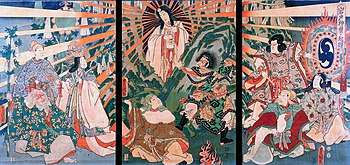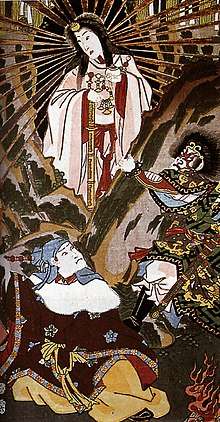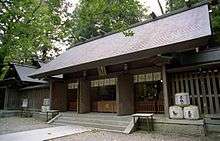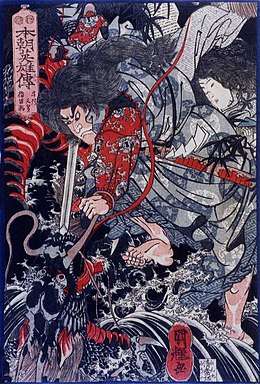Amaterasu
Amaterasu (Japanese: 天照), Amaterasu-ōmikami (天照大神/天照大御神/天照皇大神), or Ōhirume-no-muchi-no-kami (大日孁貴神) is the Shinto sun goddess. She is also seen as the goddess of the universe. As a major deity, she also appears in Japanese mythology, especially in the two earliest written records, the Kojiki and the Nihon Shoki.
| Amaterasu | |
|---|---|
Goddess of the Sun and universe | |
 Amaterasu emerging from the cave, Ama-no-Iwato, to which she once retreated (painted by Kunisada) | |
| Other names | Amaterasu-ōmikami, Ōhirume-no-muchi-no-kami |
| Planet | Sun |
| Personal information | |
| Parents | Izanagi or Izanagi and Izanami |
| Siblings | Tsukuyomi, Susanoo |
| Children | Oshihomimi, Amenohohi, Amatsuhikone, Ikutsuhikone, Kumanokusubi, Takiribime, Tagitsuhime, Ichikishimahime |
| Greek equivalent | Helen of Troy,[1][2][3] Demeter[4] |
| Roman equivalent | Ceres[4] |
The name Amaterasu is derived from Amateru and means "shining in heaven". The meaning of her whole name, Amaterasu-ōmikami, is "the great august kami (deity) who shines in the heaven".[N 1] According to the Kojiki and Nihon Shoki chronicles in Japanese mythology, the Emperors of Japan are considered to be direct descendants of Amaterasu.
History

Records of the worship of Amaterasu are found from the c. 712 CE Kojiki and c. 720 CE Nihon Shoki, the oldest records of Japanese history. In Japanese mythology, Amaterasu, the goddess of the sun, is the sister of Susanoo, the god of storms and the sea, and of Tsukuyomi, the god of the moon. It was written that Amaterasu had painted the landscape with her siblings while she created ancient Japan.[6] Amaterasu was said to have been created by the divine couple Izanagi and Izanami, who were themselves created by, or grew from, the originator of the universe, Amenominakanushi.[7] All three deities were born from Izanagi when he was purifying himself upon entering Yomi, the underworld, after breaking the promise not to see dead Izanami and he was chased by her and Yakusan-no-ikaduchigami (八雷神), surrounding rotten Izanami. Amaterasu was born when Izanagi washed out his left eye, Tsukuyomi was born from the washing of the right eye, and Susanoo from the washing of the nose.
Amaterasu became the ruler of the sun and the heavens along with her brother, Tsukuyomi as the ruler of the night, and Susanoo as the ruler of the seas.[8] Originally, Amaterasu shared the sky with Tsukuyomi, her husband and younger brother until, out of disgust, he killed the goddess of food, Uke Mochi, when she pulled "food from her rectum, nose, and mouth".[9] This killing upset Amaterasu causing her to label Tsukuyomi an evil god and split away from him; separating night from day.
The texts also tell of a long-standing rivalry between Amaterasu and her other brother, Susanoo. Susanoo is said to have insulted Amaterasu, claiming she had no power over the higher realm.[10] When Izanagi ordered him to leave Heaven, he went to bid his sister goodbye. Amaterasu was suspicious, but when Susanoo proposed a challenge to prove his sincerity, she accepted. Each of them took an object belonging to the other and from it, birthed deities. Amaterasu birthed three female deities from Susanoo's sword while he birthed five male deities from her necklace. Claiming the gods were hers because they were born of her necklace, and the goddesses were his, she decided that she had won the challenge, as his item produced women. After Susanoo's defeat he went on a rampage destroying much of the heavenly and earthly realm, including Amaterasu's rice fields; he also hurled a flayed pony at her loom, and killed one of her beloved attendants in a fit of rage. Amaterasu, who was in fury and grief, hid inside the Ama-no-Iwato ("heavenly rock cave"), plunging the earth into darkness and chaos. Eventually, she was persuaded to leave the cave. Initially, Omoikane threw a party outside of the Ama-no-Iwato to lure Amaterasu out but it was not until the Goddess Ame-no-Uzume danced promiscuously outside of the cave that Amaterasu came out.[11] Susanoo was punished by being banished from heaven. Both later amended their conflict when Susanoo gave her the Kusanagi-no-Tsurugi sword as a reconciliation gift.
According to legend, Amaterasu, who was responsible for keeping balance and harmony within the earthly realm, bequeathed to her descendant Ninigi: the mirror, Yata no Kagami; the jewel, Yasakani no Magatama; and the sword, Kusanagi-no-Tsurugi. Collectively, the sacred mirror, jewel, and sword became the three Imperial Regalia of Japan.
Worship

The Ise Grand Shrine (伊勢神宮 Ise Jingū) located in Ise, Mie Prefecture, Japan, houses the inner shrine, Naiku, dedicated to Amaterasu. Her sacred mirror, Yata no Kagami, is said to be kept at this shrine as one of the Imperial regalia objects.[12] A ceremony known as Jingū Shikinen Sengū (神宮式年遷宮) is held every twenty years at this shrine to honor the many deities enshrined, which is formed by 125 shrines altogether. New shrine buildings are built at a location adjacent to the site first. After the transfer of the object of worship, new clothing and treasure and offering food to the goddess the old buildings are taken apart.[12] The building materials taken apart are given to many other shrines and buildings to renovate.[12] This practice is a part of the Shinto faith and has been practiced since the year 690 CE, but is not only for Amaterasu but also for many other deities enshrined in Ise Grand Shrine.[13] Additionally, from the late 7th century to the 14th century, an unmarried princess of the Imperial Family, called "Saiō" (斎王) or itsuki no miko (斎皇女), served as the sacred priestess of Amaterasu at the Ise Shrine upon every new dynasty.[14]
The Amanoiwato Shrine (天岩戸神社) in Takachiho, Miyazaki Prefecture, Japan is also dedicated to Amaterasu and sits above the gorge containing Ama-no-Iwato.
The worship of Amaterasu to the exclusion of other kami has been described as "the cult of the sun."[15] This phrase may also refer to the early pre-archipelagoan worship of the sun.[15]
According to the Engishiki (延喜式) and Sandai Jitsuroku (三代実録) of the Heian period, the sun goddess had many shrines named "Amateru" or "Amateru-mitama", which were mostly located in the Kinki area. However, there have also been records of a shrine on Tsushima Island, coined as either "Teruhi Gongen" or the "Shining Sun Deity" during medieval times. It was later found that such a shrine was meant for a male sun deity named Ameno-himitama.[14]
Amaterasu was also once worshiped at Hinokuma shrines. The Hinokuma shrines were used to worship the goddess by the Ama people in the Kii Provinces. Because the Ama people were believed to have been fishermen, researchers have conjectured that the goddess was also worshiped for a possible connection to the sea.[14]
Differences in worship
Amaterasu, while primarily being the goddess of the sun, is also sometimes worshiped as having connections with other aspects and forms of nature. Amaterasu can also be considered a goddess of the wind and typhoons alongside her brother, and even possibly death.[16] There are many connections between local legends in the Ise region with other goddesses of nature, such as a nameless goddess of the underworld and sea. It's possible that Amaterasu's name became associated with these legends in the Shinto religion as it grew throughout Japan.[17]
In contrast, Amaterasu, while enshrined at other locations, also can be seen as the goddess that represents Japan and its ethnicity. The many differences in Shinto religion and mythology can be due to how different local gods and beliefs clashed.[17] In the Meiji Era, the belief in Amaterasu fought against the Izumo belief in Okininushi for spiritual control over the land of Japan. During this time, the religious nature of Okininushi may have been changed to be included in Shinto mythology.[18] Osagawara Shouzo built shrines in other countries to mainly spread Japan's culture and Shinto religion. It, however, was usually seen as the worshiping of Japan itself, rather than Amaterasu.[19] Most of these colonial and oversea shrines were destroyed after WWII. [20]
Other worshiped forms
Snake
Outside of being worshiped as a sun goddess, some have argued that Amaterasu was once related to snakes.[14] There was a legend circulating among the Ise Priests that essentially described an encounter of Amaterasu sleeping with the Saiō every night in the form of a snake or lizard, evidenced by fallen scales in the priestess' bed.[14] This was recorded by a medieval monk in his diary, which stated that "in ancient times Amaterasu was regarded as a snake deity or as a sun deity."[21] In the Ise kanjō, the god's snake form is considered an embodiment of the "three poisons", namely greed, anger, and ignorance.[22] Amaterasu is also linked to a snake cult, which is also tied to the theory that the initial gender of the goddess was male.[21]
Dragon
In general, some of these Amaterasu-dragon associations have been in reference to Japanese plays. One example has been within the Chikubushima tradition in which the dragon goddess Benzaiten was the emanation of Amaterasu.[23] Following that, in the Japanese epic, Taiheki, one of the characters, Nitta Yoshisada (新田義貞), made comparisons with Amaterasu and a dragon with the quote: “I have heard that the Sun Goddess of Ise … conceals her true being in the august image of Vairocana, and that she has appeared in this world in the guise of a dragon god of the blue ocean.”[23]
Another tradition of the Heavenly Cave story depicts Amaterasu as a "dragon-fox" (shinko or tatsugitsune) during her descent to the famed cave because it is a type of animal/kami that emits light from its entire body.[24]
Relation to women's positions in early Japanese society
Because Amaterasu has the highest position among the Shinto deities, there has been debate on her influence and relation to women's positions in early Japanese society. Some scholars have argued that the goddess' presence and high stature within the kami system could suggest that early rulers in Japan were female.[25] Others have argued the goddess' presence implies strong influences female priests had in Japanese politics and religion.[25]
See also
Popular culture
- Ōkami Amaterasu, fictional character from video game Ōkami
- Shinto in popular culture
Notes
| Look up amaterasu in Wiktionary, the free dictionary. |
- ama means "heaven"; tera is an inflectional form of teru, "to shine"; su is an honorific auxiliary verb that shows respect for the actor; then, amaterasu means "to shine in the heaven"; ō means "big" or "great"; mi is a prefix for noble and august beings.[5]
References
- O'Brien, Steven. "Dioscuric Elements in Celtic and Germanic Mythology". In: Journal of Indo-European Studies 10:1–2 (Spring–Summer, 1982), pp. 117–136.
- Dexter, Miriam Robbins. "Proto-Indo-European Sun Maidens and Gods of the Moon." In: Mankind Quarterly 25:1–2 (Fall/Winter, 1984), pp. 137–144.
- Meagher, Robert E. (2002). The Meaning of Helen: In Search of an Ancient Icon. Bolchazy-Carducci Publishers. pp. 46ff. ISBN 978-0-86516-510-6.
- Kárpáti, János (1993). "Amaterasu and Demeter: About a Japanese – Greek Mythological Analogy". International Journal of Musicology. 2: 9–21. JSTOR 24617979.
- Akira Matsumura, ed. (1995). 大辞林. Daijirin (in Japanese) (2nd ed.). Sanseido Books. ISBN 978-4385139005.
- Wallin, edited by Anne Buttimer, Luke (1999). Nature and Identity in Cross-Cultural Perspective. Dordrecht: Springer Netherlands. ISBN 9789401723923.CS1 maint: extra text: authors list (link)
- Watts Barton, David (January 24, 2017). "Amaterasu and the Gods of Ancient Japan". japanology.org. Innovation Design Co. Archived from the original on March 2, 2017. Retrieved April 10, 2017.
- Cotterell, Arthur (2005). World Mythology. United Kingdom: Parragon Publishing. p. 195. ISBN 978-1-40544-767-6.
- Roberts, Jeremy (2010). Japanese Mythology A To Z (PDF) (2nd ed.). New York: Chelsea House Publishers. ISBN 978-1604134353. Archived (PDF) from the original on 2017-11-19. Retrieved 2012-04-04.
- Kumar, Samir (2015). "Amaterasu (mythology)". Salem Press Encyclopedia.
- Ellwood Jr., Robert S. (December 1973). "Shinto and the Discovery of History of Japan". Journal of the American Academy of Religion. 41 (4): 493–505. doi:10.1093/jaarel/XLI.4.493. JSTOR 1461729.
- Ellwood, Robert S. (1968). "Harvest and Renewal at the Grand Shrine of Ise". Numen. 15 (3): 165–190. doi:10.2307/3269575. ISSN 0029-5973. JSTOR 3269575.
- Cristina, Martinez-Fernandez; Naoko, Kubo; Antonella, Noya; Tamara, Weyman (2012-11-28). Demographic Change and Local Development Shrinkage, Regeneration and Social Dynamics: Shrinkage, Regeneration and Social Dynamics. OECD Publishing. ISBN 9789264180468.
- Takeshi, Matsumae (1978). "Origin and Growth of the Worship of Amaterasu". Asian Folklore Studies. 37 (1): 1–11. doi:10.2307/1177580. JSTOR 1177580.
- Wheeler, Post (1952). The Sacred Scriptures of the Japanese. New York: Henry Schuman. pp. 393–395. ISBN 978-1425487874.
- Metevelis, Peter. "The Deity and Wind of Ise".
- Akira, Toshio (1993). "The Origins of the Grand Shrine of Ise and the Cult of the Sun Goddess Amaterasu". 4. doi:10.15055/00000383. Cite journal requires
|journal=(help) - Zhong, Yijiang. "Freedom, Religion, and the Making of the Modern State in Japan, 1868-89".
- Nakajima, Michio. "Shinto Deities that Crossed the Sea: Japan's "Oversea Shrines" 1868-1945".
- Suga, Koji. "A Concept of Overseas Shinto Shrines: A Pantheistic Attempt by Ogasawara and Its Limitation".
- Kidder, Jonathan Edward (2007). Himiko and Japan's Elusive Chiefdom of Yamatai: Archaeology, History, and Mythology. Honolulu: University of Hawai'i Press. p. 265. ISBN 978-0-8248-3035-9.
- Breen, John; Teeuwen, Mark (2013). Shinto in History: Ways of the Kami. Oxon: Routledge. p. 109. ISBN 978-1-136-82704-4.
- Faure, Bernard (2015-12-31). Protectors and Predators: Gods of Medieval Japan, Volume 2. University of Hawai'i Press. doi:10.21313/hawaii/9780824839314.001.0001. ISBN 9780824839314. S2CID 132415496.
- Breen, John; Teeuwen, Mark (2000). Shinto in History: Ways of the Kami. University of Hawaii Press. ISBN 9780824823634.
- Roberts, Jeremy, 1956- (2010). Japanese mythology A to Z (2nd ed.). New York, NY: Chelsea House Publishers. ISBN 9781438128023. OCLC 540954273.CS1 maint: multiple names: authors list (link)
